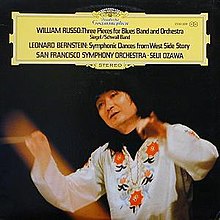Three Pieces for Blues Band and Symphony Orchestra
| Three Pieces for Blues Band and Symphony Orchestra | ||||
|---|---|---|---|---|
 |
||||
| Studio album by Siegel–Schwall Band | ||||
| Released | 1973 | |||
| Genre | Blues rock, third stream, classical crossover, avant-garde | |||
| Label | Deutsche Grammophon | |||
| Producer | Thomas Mowrey | |||
| Siegel–Schwall Band chronology | ||||
|
||||
| Alternate cover | ||||

1977 Polydor Records release
|
||||
| Professional ratings | |
|---|---|
| Review scores | |
| Source | Rating |
| Allmusic |
|
Three Pieces for Blues Band and Symphony Orchestra is an avant-garde musical composition written by William Russo in 1968. It combines classical music played by an orchestra with blues played by a four-piece band.
Three Pieces for Blues Band and Symphony Orchestra was recorded in 1972 by the San Francisco Symphony and the Siegel–Schwall Band, conducted by Seiji Ozawa. When the album was released the following year by Deutsche Grammophon, it became one of the company's best selling records, reaching number 21 on the Billboard Jazz Chart and number 105 on the Billboard 200. Side two of the original LP record was Symphonic Dances from West Side Story by Leonard Bernstein. When the album was reissued on CD in 2002, the Bernstein piece was omitted in favor of An American in Paris by George Gershwin and another Russo composition combining classical and blues, Street Music: A Blues Concerto.
In 1966, Seiji Ozawa saw the Siegel–Schwall Band perform live at Big John's in Chicago. The Siegel–Schwall Band was a blues rock group led by Corky Siegel (harmonica, piano, vocals) and Jim Schwall (guitar, vocals). Ozawa conceived the idea of combining blues and classical music. The following year, Ozawa conducted a performance of William Russo's Symphony No. 2, Titans, at the Ravinia Festival. Shortly after that, Russo was commissioned to write and orchestrate the composition that became Three Pieces for Blues Band and Symphony Orchestra. Russo consulted with Siegel when writing this work. While the orchestral parts are fully delineated, the blues band parts are more broadly outlined, leaving significant room for musical improvisation.
...
Wikipedia
